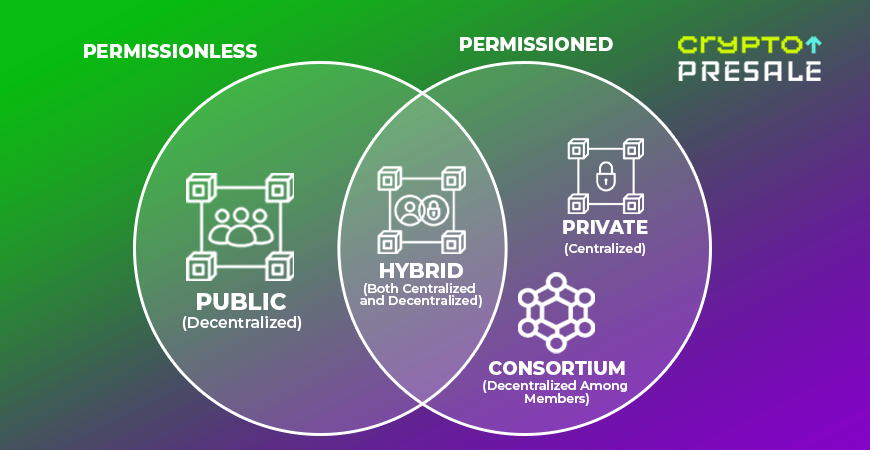Serving as the backbone of cryptocurrencies, blockchain technology has transformed transaction data security, processing, and trust establishment across various industries.
To provide a deeper understanding of its versatility, this write-up explores the four most popular types of blockchain applications – public, private, consortium, and hybrid. In addition, this article will also cover the latest innovations in blockchain technology, while discussing potential future developments in the space.
Blockchain Types (Quick Summary)
| Type | Access | Control | Typical Use Cases | Key Characteristics |
| Public | Open to everyone | Decentralized | Cryptocurrencies, Public data management | Fully decentralized, transparent, secure, energy-intensive |
| Private | Restricted access | Centralized | Enterprise operations, Supply chain management | Faster transactions, scalable, more private, controlled access |
| Consortium | Limited to select groups | Decentralized among members | Banking, Research, Supply chains | Partially decentralized, secure, efficient among members, less transparent |
| Hybrid | Controlled public access | Both decentralized and centralized | Real estate, Healthcare, Government services | Combines features of both private and public, customizable privacy and transparency |
4 Types of Blockchains: Advantages, Disadvantages, Applications and Examples
Below is an in-depth look at different types of blockchains.
Public Blockchains: Openness and Security For Everyone

Public blockchains, as the name suggests, allow anyone to join their resources and become a part of the network.
In essence, they are permissionless distributed ledgers that anyone can join, therefore embodying the true spirit of open-access technology. This means that anyone with an internet connection can partake as an authorized node, undertaking key roles such as transaction verification and mining, which are the primary functions within a blockchain.
Advantages of Public Blockchains
- Trust and Security: Their decentralized and cryptographic foundations make public blockchains highly secure and trustworthy. As most public blockchains use consensus mechanisms such as proof-of-work (PoW), this ensures that nodes operate without needing to trust one another, effectively mitigating the risk of fraudulent transactions.
- Transparency: The vast network of nodes not only enhances security but also reinforces the integrity of the data recorded on the blockchain. This transparency is particularly vital in sectors like fundraising and voting, where clear, accessible records are absolute must.
- Decentralization: With no central authority, networks are collectively maintained by all participants – which in turn preserves the essence of decentralization.
Disadvantages of Public Blockchains
- Scalability and Speed: Typically large network sizes can slow down transaction processing and significantly impact scalability. As scalability is a critical factor for industries that demand high-speed transaction capabilities – such as finance – this makes public blockchains unsuitable for such tasks.
- Energy Consumption: Intensive computational tasks, especially in mining, require significant amounts of energy, raising environmental and economic concerns.
Real-World Applications of Public Blockchains
Public blockchains are ideal for applications that require openness and trust, such as:
- Voting Systems: Ensures transparency and security in governmental elections.
- Fundraising: Facilitates trust and transparency for organizations seeking to raise funds.
- Auditable Records: Provides a transparent and secure method for record-keeping and notarization across various industries.
Examples of Public Blockchains
- Bitcoin: The original and most well-known cryptocurrency, operating on a public ledger.
- Ethereum: A world-leading decentralized Layer 1 blockchain that enables smart contracts and decentralized applications (dApps).
- Litecoin: A peer-to-peer cryptocurrency often considered as the ‘silver’ to Bitcoin’s ‘gold’.
Also Read: Our comprehensive guide on Public Blockchains for more information.
Private Blockchains: Efficiency and Control in Closed Networks

Private blockchains are a specialized subset within the broader blockchain ecosystem, designed to operate within restricted environments such as closed networks controlled by a single entity.
Often referred to as permissioned or enterprise blockchains, these systems are characterized by a smaller and more controlled setting compared to their public counterparts, tailored for specific organizational needs.
Advantages of Private Blockchains
The controlled nature of private blockchains brings several benefits, especially in terms of operational efficiency:
- Speed and Efficiency: With fewer nodes to manage, private blockchains can process transactions much faster than public blockchains. This is crucial for applications where time is of the essence, such as financial transactions.
- Scalability: Organizations can scale their blockchain infrastructure up or down based on specific requirements, making private blockchains highly adaptable to varying business needs.
- Privacy and Data Control: Private blockchains offer enhanced privacy since access to the blockchain is restricted to authorized users only. This is particularly important for handling sensitive financial data or corporate secrets.
- Managed Access: The ability to control who participates in the blockchain network ensures that internal processes and data remain secure and confidential, aligning with organizational policies and compliance requirements.
Disadvantages of Private Blockchains
Private blockchains also come with certain drawbacks that need consideration, such as:
- Centralization Concerns: The central control of private blockchains contradicts the decentralization ethos of traditional blockchains, which often raises issues regarding data authenticity and manipulation risks.
- Security Risks: With fewer nodes available to validate transactions, private blockchains can be more susceptible to security breaches if one or more nodes are compromised.
- Limited Trust: The reliance on a smaller group of participants can hinder the establishment of trust compared to the trustless nature of public blockchains.
Real-World Applications of Private Blockchains
Private blockchains are particularly well-suitable for applications where control, privacy, and speed are paramount.
- Supply Chain Management: They can streamline supply chain operations by providing a transparent and efficient record of transactions and asset tracking, accessible only to authorized stakeholders.
- Asset Ownership and Verification: Private blockchains facilitate the secure and efficient verification of asset ownership, which is crucial in industries such as real estate or finance.
- Internal Voting Systems: Organizations can use private blockchains in order to conduct secure and transparent internal voting, ensuring that all votes are accurately recorded and immune to tampering.
Examples of Private Blockchains
- Hyperledger Fabric: An open-source enterprise-grade platform used to develop private blockchain applications.
- Corda: A private blockchain platform designed for business, enabling direct transactional privacy.
- Quorum: An enterprise-focused version of Ethereum, tailored for high-speed and high-throughput transactions.
Also Read: Our comprehensive guide on Private Blockchains for more information.
Hybrid Blockchains: Balancing Privacy and Transparency

Hybrid blockchains are a somewhat novelty in the blockchain space, as they blend the features of private and public blockchains to give end users the best of both worlds.
This model allows organizations to create a tailored environment where a private, permission-based system coexists with a public, permissionless one. This dual structure enables hybrid blockchains to offer a flexible approach, adapting data access and transparency to suit specific organizational needs.
Advantages of Hybrid Blockchains
Hybrid blockchains provide a unique mix of benefits that make them appealing for various applications:
- Enhanced Security: Operating within a controlled environment, hybrid blockchains are less vulnerable to external attacks – such as notorious 51% attacks which are a concern for less secure networks.
- Cost-Effectiveness and Scalability: By facilitating selective interaction with third parties, hybrid blockchains can perform transactions that are both economical and fast, offering better scalability compared to public blockchains.
- Customizable Privacy and Transparency: Organizations can decide which data remains private or public, providing an optimal balance that meets both operational and compliance requirements.
Disadvantages of Hybrid Blockchains
- Limited Transparency: The ability to restrict information visibility may raise concerns, particularly in sectors like finance where transparency is critical for trust and compliance.
- Maintenance and Upgrade Challenges: Hybrid systems can be complex to maintain and upgrade, potentially limiting their adaptability to changing technological or business needs.
- Reduced Incentives: The closed nature of parts of the network may decrease incentives for users to participate or contribute, affecting the blockchain’s robustness and security.
Real-World Applications of Hybrid Blockchains
Hybrid blockchains are versatile, meaning they find utility in sectors that require a balance between privacy and public transparency:
- Real Estate: Companies can manage sensitive data privately while publicly sharing essential information such as property listings.
- Retail: Hybrid blockchains help streamline operations by managing inventory and customer data efficiently, ensuring both security and ease of access for necessary information.
- Highly Regulated Industries: In sectors like banking and healthcare where compliance and data protection are paramount, hybrid blockchains provide a framework that meets regulatory standards whilst also allowing for necessary public disclosures.
Examples of Hybrid Blockchains
- Dragonchain: A platform that allows businesses to retain control over their data while still connecting with public blockchains.
- XinFin Network (XDC): Aims to combine the benefits of both private and public blockchains for global trade and finance.
- Ripple: Utilizes a hybrid blockchain where the network is managed by a network of independent validating servers that constantly compare their transaction records.
Also Read: Our comprehensive guide on Hybrid Blockchains for more information.
Consortium Blockchains: Collaborative Efficiency in Decentralized Networks

Similar to hybrid blockchains, consortium blockchains blend elements of private and public blockchains together. What therefore makes them different is their governance structure.
This is because the governance of consortium blockchains involves multiple organizations collaborating with one another on a decentralized network. This is because designated nodes from across the globe handle the consensus process for a given blockchain network, in order to ensure that no single entity holds complete control over it.
Advantages of Consortium Blockchains
The design of consortium blockchains offers several key benefits, particularly suitable for environments wherein cooperation between different entities is essential:
- Enhanced Security and Control: With predetermined nodes responsible for consensus and validation, consortium blockchains are less prone to hack attacks compared to public blockchains.
- Efficiency and Scalability: Due to the limited and selected participation, these blockchains can process transactions quicker than their public counterparts, as well as scale more effectively.
- Balanced Governance: The shared control among various organizations distributes authority and prevents any single point of failure, therefore enhancing the system’s resilience and trustworthiness.
- Privacy With Oversight: While offering better privacy than public blockchains, consortium blockchains still allow for a level of oversight and transparency among the approved participants.
Disadvantages of Consortium Blockchains
- Limited Transparency: Consortium blockchains do not offer the same level of transparency as public blockchains, which can be a concern for scenarios requiring full transparency.
- Potential for Collusion: If not properly regulated, their collaborative nature could potentially lead to collusion among participants.
- Complex Governance: Managing a consortium blockchain can be challenging due to the requirement to align interests and policies among different organizations.
Real-World Applications of Consortium Blockchains
Consortium blockchains are particularly effective in sectors where collaboration across multiple entities is beneficial:
- Banking and Financial Services: Banks and financial institutions can form consortia to manage and validate transactions securely and efficiently, therefore reducing the reliance on central clearing houses or exchange entities.
- Research and Data Sharing: In academic or pharmaceutical research, consortium blockchains can facilitate the secure sharing of data and research outcomes.
- Supply Chain Management: Consortium blockchains are ideal for tracking the provenance and status of goods across a supply chain, particularly in industries like food and medicine where handling and origin verification is critical.
Examples of Consortium Blockchains
- R3’s Corda: Designed for the financial industry, Corda allows for private transactions with a group of trusted entities.
- Hyperledger: A collaborative effort created to advance cross-industry blockchain technologies.
- Quorum: Developed by J.P. Morgan, Quorum is a permissioned implementation of Ethereum supporting data privacy.
Also Read: Our comprehensive guide on Consortium Blockchains for more information.
Permissionless and Permissioned Blockchains

Permissionless and permissioned blockchains are categories based on access control, and they fit into broader types of blockchains as follows:
- Public Blockchains: Always permissionless, meaning anyone can join and participate (e.g., Bitcoin, Ethereum).
- Private Blockchains: Always permissioned, restricting participation to specific entities (e.g., Hyperledger Fabric).
- Consortium Blockchains: Permissioned, with a group of organizations managing the network collectively (e.g., R3 Corda).
- Hybrid Blockchains: Can be either permissionless or permissioned, combining elements of both public and private blockchains (e.g., Dragonchain).
Emerging Trends and the Future of Blockchain Types

Innovations in Blockchain Technology
As blockchain technology matures, innovations aimed at enhancing scalability, efficiency, and functionality are continually emerging. One of the most significant developments in this area is sharding.
Sharding breaks down the blockchain into smaller, manageable pieces – or “shards” – allowing transactions to be processed in parallel rather than sequentially. This method significantly increases transaction throughput and overall network performance. Ethereum’s transition to Ethereum 2.0 is a prime example of this, as the network began incorporating sharding in order to address its scalability issues.
Another notable innovation is Layer 2 scaling solutions, such as rollups and sidechains, which operate on top of the base blockchain layer. These technologies process transactions off the main chain and then subsequently record them on it, thereby reducing the load and speeding up processing times without compromising the security features of the base layer.
Interoperability protocols are also gaining traction, with projects like Polkadot and Cosmos building frameworks that enable different blockchains to communicate and share information seamlessly. This not only enhances the functionality of existing blockchains, but also opens up new possibilities for collaborative applications across different platforms.
Potential Future Types of Blockchains and Their Applications
Looking ahead, we can expect the development of more specialized blockchain types tailored to specific industries or use cases. For instance, AI-enhanced blockchains could emerge, wherein artificial intelligence is used to optimize consensus mechanisms and automate network management. In turn, this could potentially reduce the need for human intervention within operations such as smart contract execution and anomaly detection.
Quantum-resistant blockchains are another area of future development. As quantum computing advances, existing cryptographic techniques may become vulnerable. Quantum-resistant blockchains will employ new types of cryptographic algorithms that are secure against quantum attacks, thus preserving the integrity and security of blockchain data against future technological shifts.
Additionally, environmentally sustainable blockchains are expected to become more prevalent. These would use consensus algorithms that require significantly less energy than traditional proof-of-work systems, aligning with global efforts towards energy efficiency and sustainability.
Evolution of Blockchain Types with Technological Advancements
As technology evolves, so too will the various types of blockchains:
- Public blockchains might become more scalable and environmentally sustainable, overcoming some of the major criticisms they face today. With advances like proof-of-stake consensus mechanisms, public blockchains could also drastically reduce their energy consumption while still maintaining security and decentralization.
- Private blockchains are likely to become more integrated with enterprise IT systems, as well as smarter in handling complex, automated business processes through advancements in AI and machine learning. This integration will enhance their appeal to corporations looking for secure, scalable, and efficient ways to manage data internally.
- Consortium blockchains could evolve to facilitate even more complex cooperation between enterprises, powered by smart contracts that are capable of executing sophisticated, multi-party agreements automatically. Enhanced privacy features and fine-grained access controls are likely to develop further, making consortium blockchains even more robust and versatile for corporate use.
- Hybrid blockchains will likely advance in ways that allow even more flexible and dynamic data privacy and visibility settings. Innovations in this area could allow organizations to switch seamlessly between different blockchain models depending on the specific needs of a transaction or application.
Types of Blockchain Technology – FAQs
How many blockchains are there?
It’s hard to give an exact number, but there are hundreds of active blockchains, each designed for different purposes. These range from large public blockchains like Bitcoin and Ethereum, to various private and consortium blockchains that are tailored to specific industry needs.
What is the most common type of blockchain?
Public blockchains are the most common type. They are widely recognized and used due to their open, decentralized nature, with Bitcoin and Ethereum being the most notable examples.
Are hybrid blockchains common in the industry?
Not really. Hybrid blockchains are less common than public and private blockchains but are gaining traction in industries that require both transparency and privacy. They are particularly useful where businesses need to keep some data private while also sharing other information on a public ledger.
Which type of blockchain is the most secure?
Consortium blockchains are often considered the most secure for organizational use as they combine the security features of private blockchains with the decentralized management of public blockchains. However, the security level depends heavily on the specific implementation and operational protocols of the blockchain.
Why do we need different types of blockchains?
Different types of blockchains cater to different needs. Each application demands unique features such as scalability, security, and privacy. So, the right blockchain type depends on these requirements and the intended users to ensure the solution meets their objectives effectively.
 Never miss an Update!
Never miss an Update!  Top Cryptos to buy?
Top Cryptos to buy?







